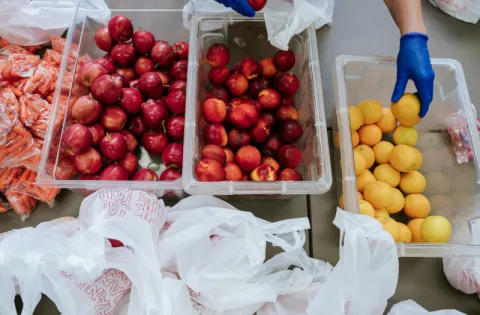
As children return to school around the country, millions of them will face their day on empty stomachs because there isn’t enough food at home. 1 in 6 kids in the U.S. struggles with hunger, but school meals can help. School breakfast is a critical way to ensure kids get the consistent nutrition they need to feel better, learn more and grow up strong.
Here are five things you should know about the role of school breakfast in the lives of hungry children.
Breakfast is an education issue
Just like textbooks and pencils, teachers see food and nutrition as a basic school supply that's instrumental to a student's success. According to our recent Hunger in Our Schools report, 3 out of 4 educators see students who regularly come to school hungry because they’re not getting enough to eat at home.
And they recognize the toll it takes. When students don’t get enough to eat, 80% of teachers see them lose the ability to concentrate and 76% see poor academic performance. This impacts kids’ ability to succeed. Access to school meals like breakfast not only reduces growling tummies, but increases test scores and graduation rates.
Skipping breakfast has a negative effect on health and behavior
When students miss a healthy morning meal they go to class hungry and are more likely to experience health issues. 62% of teachers see behavior and discipline problems when kids come to class hungry, and 47% see sicker and less healthy students. Studies show that children from low-income families who eat school breakfast miss less school days.
Only a fraction of kids who qualify for school breakfast are eating it
59% of children from low-income families say they’ve come to school hungry. While free and reduced-price school meals work to close the gap between kids who have enough to eat and those that don’t, the traditional way of serving breakfast before the school day starts is ineffective. Bus and carpool schedules make getting to school extra early a challenge for many kids from working families. As a result, only a fraction of the students who may need breakfast are unable to access it. Making breakfast part of the regular school day solves that problem.
Stigma prevents kids from accessing the food they need
When schools serve breakfast in the cafeteria before class, kids will go hungry to avoid the feeling of being labeled. When everyone eats together, it creates a feeling of community in the classroom, and kids who need that morning meal no longer feel singled out as the “poor kids.”
There are more effective and efficient ways to serve breakfast
School breakfast is critical for kids from low-income families. But, the traditional method of serving the meal before the school day starts is ineffective. Moving school breakfast out of the cafeteria and making it a part of the school day ensure that more low-income students are able to start the day with a healthy meal and a full stomach.
For more information about the scope of the problem, and role that school meals play in solving it, see our latest Hunger in Our Schools report.
Need an infographic? Click here to download one you can use or share.


